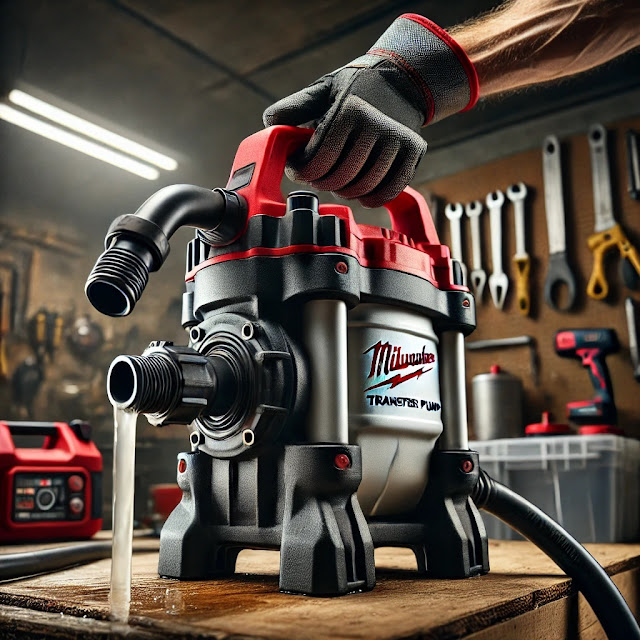Introduction
Milwaukee has been a pioneer in the development of innovative tools and equipment for decades, with transfer pumps being one of their significant contributions to various industries. Transfer pumps play a crucial role in moving liquids from one location to another in a range of applications, including construction, agriculture, and industrial processes. This article explores the evolution of Milwaukee transfer pumps, starting from manual systems to the advanced powered solutions that dominate the market today.
With each innovation, Milwaukee has enhanced the efficiency, reliability, and versatility of its pumps, improving the way industries manage fluid transfer tasks. Let's explore how these pumps have transformed over time and the benefits they bring to modern operations.
The Beginnings: Manual Transfer Pumps
Milwaukee’s journey with transfer pumps began with the development of simple, manually operated models. These early pumps were designed for small-scale fluid transfer operations, requiring the user to physically operate the pump by hand. Although effective for their time, these manual pumps had several limitations in terms of capacity and efficiency.
Key Features of Manual Transfer Pumps:
- Manual Operation: Hand-powered pumps were labor-intensive, requiring constant manual effort to move liquid.
- Limited Capacity: Suitable only for small volumes of liquids, such as water, oil, or fuel.
- Durability: Early manual pumps were built with durable materials, making them reliable for light-duty applications.
Despite their simplicity, manual pumps laid the foundation for more sophisticated systems. They were popular in applications where electricity was not available or for users requiring portability. However, as industrial demands increased, the need for more efficient and less labor-intensive solutions became evident.
The Rise of Powered Pumps: Increased Efficiency and Capacity
As industrial needs expanded, so did the capabilities of transfer pumps. Milwaukee introduced powered transfer pumps, which significantly increased the speed, capacity, and convenience of fluid transfer. These pumps were designed to handle larger volumes of liquids with minimal manual intervention.
Types of Powered Transfer Pumps:
Electric-Powered Pumps: Milwaukee developed electric transfer pumps to cater to industries where a constant power supply was available. These pumps eliminated the need for manual labor, making them ideal for large-scale operations. With motors driving the pumping mechanism, these units offered faster transfer rates and reduced downtime.
Battery-Powered Pumps: For portable operations or areas where electricity was inaccessible, Milwaukee introduced battery-powered pumps. These lightweight, portable models became popular in construction, fieldwork, and emergency scenarios where quick, efficient fluid transfer was required.
Benefits of Powered Transfer Pumps:
- Improved Efficiency: Powered pumps can transfer fluids at a much faster rate compared to manual systems.
- Increased Capacity: Designed to handle high volumes, Milwaukee’s powered pumps are suitable for large-scale industrial applications.
- Reduced Labor: With automatic operation, powered pumps minimize the need for manual work, improving productivity and reducing operator fatigue.
The introduction of powered pumps marked a significant shift in the way industries managed fluid transfer. Milwaukee’s innovations in powered pump technology quickly became a staple in many industrial and commercial applications, providing an essential solution for efficient liquid movement.
Advanced Pump Technologies: Smart Solutions for Modern Needs
In recent years, Milwaukee has continued to innovate, introducing advanced features to its transfer pumps to meet the demands of modern industries. Today's pumps not only focus on efficiency but also incorporate smart technologies for better control, monitoring, and performance optimization.
Key Innovations in Milwaukee Transfer Pumps:
- Smart Technology Integration: Many of Milwaukee’s latest models include Bluetooth connectivity, allowing users to monitor and control the pump remotely via a smartphone app. This enables real-time diagnostics, operational adjustments, and performance monitoring.
- Energy Efficiency: With growing concerns about energy consumption, Milwaukee has optimized its pump motors to consume less power while delivering high performance. This is especially important in industries looking to reduce operational costs.
- Corrosion-Resistant Materials: Milwaukee pumps are now built with corrosion-resistant materials, allowing them to handle more aggressive and caustic liquids such as chemicals and oils without compromising the pump’s longevity.
These innovations have made Milwaukee transfer pumps even more reliable and efficient, positioning them as industry leaders in fluid transfer technology. The integration of smart technology, in particular, has opened new possibilities for managing and optimizing fluid transfer operations.
Conclusion: A Legacy of Innovation
The evolution of Milwaukee transfer pumps from manual, labor-intensive systems to advanced, powered solutions is a testament to Milwaukee's commitment to innovation. Over the decades, these pumps have transformed from simple, hand-operated devices into technologically advanced systems that power modern industries. Whether it’s battery-powered portability or electric-powered high-capacity models, Milwaukee’s pumps continue to meet the growing demands of industries across the globe.
Milwaukee’s continuous improvements in technology, efficiency, and materials ensure that their transfer pumps will remain at the forefront of the industry for years to come. As industries evolve and demand greater precision and efficiency, Milwaukee’s transfer pumps are ready to meet those needs, delivering unparalleled performance and reliability.
FAQs
1. What are Milwaukee transfer pumps used for?
Milwaukee transfer pumps are used to move liquids such as water, oil, chemicals, and other fluids in various industries, including construction, agriculture, and manufacturing.
2. How do powered transfer pumps differ from manual pumps?
Powered transfer pumps, whether electric or battery-powered, automate the fluid transfer process, allowing for higher efficiency and capacity. Manual pumps, on the other hand, require physical effort to operate and are suitable for smaller-scale applications.
3. Can Milwaukee transfer pumps handle corrosive liquids?
Yes, many modern Milwaukee transfer pumps are made from corrosion-resistant materials, making them suitable for transferring aggressive liquids such as chemicals and oils.
4. What are the benefits of smart technology in transfer pumps?
Smart technology allows users to monitor and control their pumps remotely. It provides real-time diagnostics and operational data, making it easier to manage fluid transfer operations efficiently.
5. Are Milwaukee battery-powered transfer pumps suitable for heavy-duty applications?
While Milwaukee’s battery-powered pumps are designed for portability and convenience, they are also capable of handling demanding tasks. For continuous heavy-duty operations, electric-powered models are often more suitable.

Comments
Post a Comment